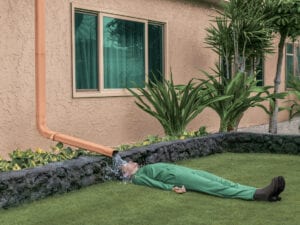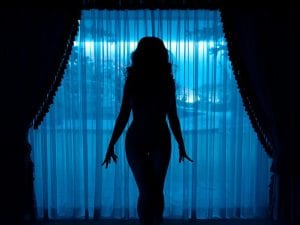Kate Ballis’s Infra Realism sits in the mysterious realm between reality and the surreal. Residing in a lucid dreamscape, it is familiar in form and yet subverts the familiar colour and scale we rely on to interpret the visions around us.
A: What is the main influence behind Infra Realism?
KB: For me the influences from this series all came from outside photography. I have been studying painting and became obsessed with colour theory and the way colours can vibrate against each other. It’s such common practise to use paint and brushes to subvert colour and create ambiguity in everyday scenes, so I began to look for a way to allow my camera to do the same. My early experiments with my infrared camera, and the various filters, gave me the tools I was looking for.
A: What has led to the more explicit visual manipulation seen in this new series, as opposed to your previous works?
KB: I love to engage unique techniques either in camera, or in post to help me express emotions in my art. While Glace Noir (my previous body of work) and Infra Realism are aesthetically different, both have been visually manipulated to create surreal otherworldly dreamscape. I think we live in a time where landscape photography is almost at its peak, we are bombarded with glossy images of beautiful places but for me there was no mystery in them. I have always sought to show places people think they know (either by visiting or seeing photos) in a new way, so the infrared process became a way to show them in a completely unpredictable way. Shooting with infrared no matter which filter you use, you end up with a window into another world. Some people use infrared to create a more realistic theme, but I have used these techniques to make them more surreal. They are hyper saturated but everything is completely subverted from the colours we expect from a landscape.
A: Why do you think photography is specifically instrumental in the distortion of reality?
KB: I almost think it’s a challenge to distort reality through photography, because the camera has been used throughout history to communicate facts. But this is something I want to challenge. Since that advent of “photoshop” people find photographs more difficult to believe. I’m interested in that and wanted to embrace the ambiguity. If people have a hard time working out whether my pictures are painting or photographs, real or fake, doctored or factual, I think that is great. Questions are far more interesting than answers. I actually wish I could paint from my imagination, as that would be the easiest way to distort reality, but I’m not there yet!
A: Is there a personal drive behind the candied reality your photographs represent?
KB: I think I can’t escape the fact that I’m a child of the 1980s who was swept up in the hyper colour dream that was marketed to us through Barbies, MTV and the vision of america depicted to us in Australia. Perhaps, in a way this series is a way of finally breaking through into the dream-land we were sold in the 1980s, and are somewhat comforting. However, through travel, as an adult, I have discovered landscapes, such as Palm Springs and Joshua Tree that are far more fantastical than those I could have imagined as child.
A: What are you trying to convey with the juxtaposition of familiar scenes and the use of obscuring digital techniques?
KB: I am trying to convey a mysterious realm that sits between reality and the surreal. I hope that the images are familiar in form, and yet the subversion of the foliage and the familiar colour and scale we rely on to interpret the visions around us, make them feel confusing, but not in a jarring sense.
A: How does the use of infrared in your work enable science and fantasy to reach equilibrium?
KB: The infrared spectrum of light emanating from plants sits just beyond the light spectrum visible to humankind. My work, in that sense, straddles science and magic, providing a glimpse into the unknown. Science provides us the information for how light works but it’s difficult to walk around imagining what this spectrum may look like. It has been fascinating to photograph a landscape that appears muted and dead but realise that the shrubs and cacti are actually alive and well and in infrared glowing brighter than anything else in the scene. What appears to the eye as a dusty brown scene is actually a glowing world. It is also interesting photographing a desert house, that is painted to blend into it’s desert background, and beautifully designed garden of succulents, and then use science to put primary focus on the beautiful desert plants. It’s a search for life and colour in places where you would not expect it to exist.
A: Would you say the natural subjects of your work are a canvas on which you can produce digital creations?
KB: Nature, particularly deserts and mountains are my primary muse and feed into all of my work. Often these landscapes already look otherworldly, as if maybe they are on the moon or mars, so I use these landscapes as a canvas to provide a glimpse into a foreign world just beyond ours, but with the familiar forms of this world’s landscapes to provide a framework for our understanding. The process continually surprises me though, to say they are a canvas implies I have the power to change their nature, in reality I can only capture what exists in the scene, the science and magic of the process do the rest.
A: What is it about your use of colours that serves to enhance the illuminations that lie beyond human observation?
KB: For Infra Realism, I intentionally create vibrations between the foliage and the sky to imitate the vibration of light and energy.
A: Who are you most influenced by?
KB: I am influenced by the infrared work of Richard Mosse, the landscapes of Georgia O’Keeffe, the practices of Hilma af Klint, the dreamscapes of Salvador Dali, and the photography of Bill Henson and Helmut Newton.
A: What do you think is the future of digital art?
KB: I think digital art has a huge future, as both a pure form and mixed media, as technology (both software and hardware) advances. Digital art permits a huge amount of experimentation. My process relies completely on the flexibility of digital infrared technology, whereas the infrared film that has been traditionally used, really only had one outcome. As the software that interprets the images improves I may be able to re-work them in completely different ways that can use the data I have already captured to show me entirely new things. That dynamic ability I think is really exciting.
Credits:
1. Kate Ballis, Infra Realism.





